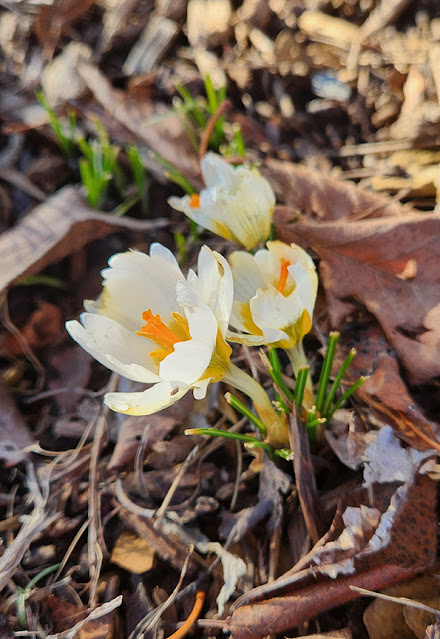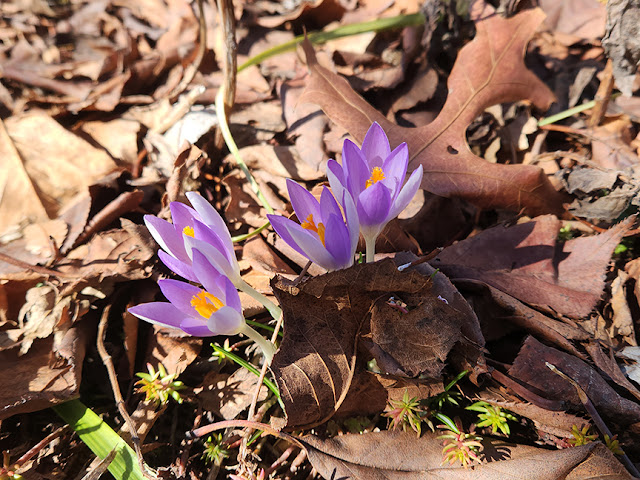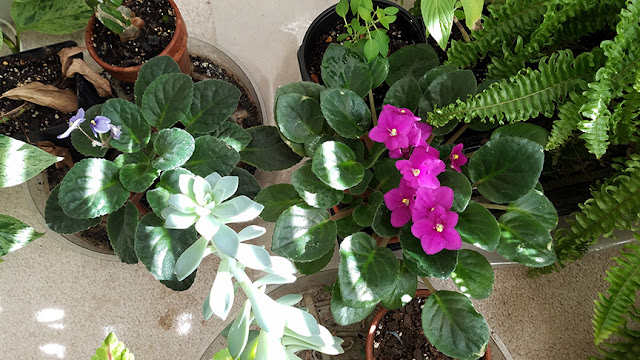 |
| Yellow species crocus |
On the 15th of very month Carol Michels' May Dreams blog hosts "Bloom Day" where we gardeners share photos of what's blooming in our gardens. Today is cloudy and cold in my Zone 6B garden in Virginia. We were expecting a bit of ice and/or snow earlier this morning, but that didn't materialize, so now it's probably going to be rain this afternoon and tonight on through tomorrow. I took my outdoor photos yesterday when it was sunny and warmer.
The species crocus in my front yard began to emerge about the beginning of the month, with the flowers opening on the few warm sunny days we've had. There is a variety of them: white, yellow with feathering on the outer petals, and the pale violet "Tommies."
I planted some 'Orange Emperor' crocus in the back bed, but those have yet to show.
 |
| White species crocus |
 |
| Violet "Tommies "(Crocus thomasinnianus) |
 |
| Assortment of crocus in the front yard. |
The snowdrops I planted two falls ago have also popped up, but they have yet to start forming clumps. Oh well, next year there should be more. The foliage of the early daffodils is also emerging.
 |
| Snowdrops (Galanthus nivalis 'Elwesii') |
 |
| Foliage of early daffodils emerging. |
The buds of my two witchhazel trees have started to open--the native Southern Witchhazel blooms at this time of the year, and the hybrid 'Diane' also.
 |
| Hybrid Witchhazel 'Diane' |
 |
| Southern Witchhazel |
The Japanese Pieris has a number of flower buds, but these won't open until later in the spring. The buds of my hybrid Hellebores nearby are still buried beneath a blanket of leaves.
 |
| Japanese Pieris (Pieris japonica) |
Indoors, I have a few surprises for you: a lovely yellow Hibiscus flower opened this morning--the first since the beginning of the year.
 |
| Hybrid yellow Hibiscus |
The Miltassia orchid in the master bath has a couple of flowering spikes and a few other Phalaenopsis have developed spikes too. The large-flowered white one below will probably open in a few more days.
 |
| Miltassia orchid. |
 | |
| White Phalaenopsis about to bloom. |
I've cared for this particular miniature Phal for seven years--that's how long it's taken to produce this one flowering spike. I'm curious to see what color the flowers will be.
This other miniature Phal faithfully blooms once and sometimes twice a year--this year it has two flowering spikes developing.
 |
| Miniature Phalaenopsis flower spikes. |
Lastly, the African violets treated for mealybugs seem to be recovering nicely.
 |
| Optimara African violets |
 |
| Bearss lime fruits. |
The fruits of the Bearss lime are increasing in size, and my Gardenia tree still has a few blooms, but that's about it for today, I hope to have more to show next month. Happy February Bloom Day!























